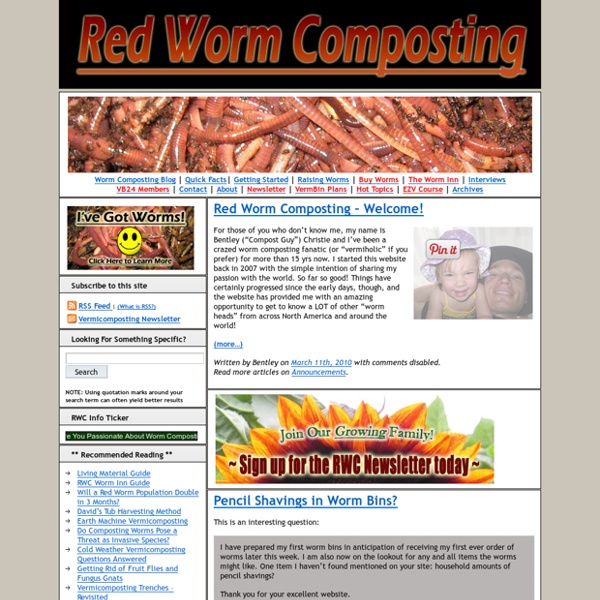



http://www.redwormcomposting.com/
Related: Gardening/Community Gardens • Permaculture practices & permutations • VermicultureList of companion plants Dill is one of the few plants to grow with Fennel This is a list of companion plants. Many more are in the list of beneficial weeds. Companion plants assist in the growth of others by attracting beneficial insects, repelling pests, or providing nutrients, shade, or support. They can be part of a biological pest control program. Vegetables[edit]
20 Urban Food Forests from Around the World The Seven Layers of a Food Forest. Diagram by Graham Burnett via Wikipedia. The concept of a food forest has its roots in permaculture, a philosophy that advocates for managing agricultural landscapes in harmony with nature. Instrumental characterization of organic wastes for evaluation of vermicompost maturity Introduction Vermicomposting is a biological process used to convert complex organic wastes into a stabilized nutrient-rich fertilizer called vermicompost. Vermicomposts are peat-like materials containing plant growth hormones and nutrients in plant available forms (Lim et al. 2016). In vermicomposting process, earthworms and microbes of their gut degrades organic waste and forms a stable and mature product (Bhat et al. 2013; Lim et al. 2016). Organic waste recycling and its use as a soil conditioner is the attractive method for waste management. The application of organic manures produced from organic wastes by vermicomposting is one of the ways to maintain soil fertility and reduce the soil pollution (Ostos et al. 2008; Bhat et al. 2016a).
Natural Fertilizer Science Project Natural Fertilizer Science Projects For The Urban Farmer Every farmer, right from an urban backyard hobbyist down to one owning acres of land, knows the importance of soil enhancement in producing healthy plants. If the soil is frail and imperfect, the produce will be weak. And if the produce is weak, then it gets vulnerable to infestation from insects. weblife.org: Humanure Handbook: Chapter 3: Compost Myths What is one of the first things to come to mind when one thinks of compost? Turning the pile. Turn, turn, turn, has become the mantra of composters worldwide.
vermicompost humic acid: Topics by Science.gov Chlorpyrifos-methyl solubilisation by humic acids used as bio-surfactants extracted from lignocelluloses and kitchen wastes. PubMed Scaglia, Barbara; Baglieri, Andrea; Tambone, Fulvia; Gennari, Mara; Adani, Fabrizio 2016-09-01 Chlorpyrifos-methyl (CLP-m) is a widely used organophosphate insecticide that can accumulate in soil and become toxic to humans. CLP-m can be removed from soil by its solubilisation using synthetic surfactants. However, synthetic surfactants can accumulate in soil causing contamination phenomena themselves. Bio-surfactants can be used as an alternative to synthetic ones, reducing costs and environmental issues. In this work, humic acid (HA) extracted from raw biomasses, i.e. lignocelluloses (HAL) and lignocelluloses plus kitchen food waste (HALF), corresponding composts (C) (HALC and HALFC) and leonardite (HAc), were tested in comparison with commercial surfactants, i.e.
Terrarium Centerpieces The other week, my good friend Stephanie and I planned out a craft weekend. Our mission: Terrariums. Not the kind you keep lizards in, but the kind you can seal up and watch the moss grow. It was fun, cheap, and easy, and while we were creating them I realized how awesome they would be as centerpieces at a wedding. hugelkultur, nature's raised garden beds FOR 25 YEARS I have grown my vegetables in raised beds, but the kind that you need to purchase lumber and bolts and use a saw and hammer to construct, then fill entirely with soil and compost. Lately I’ve been looking longingly at photos of a centuries-old, sustainable way of making raised garden beds called hugelkultur, or hill culture. “It’s like sheet mulching or lasagna gardening,” says Dave Whitinger of All Things Plants, who regularly lectures on the subject, but in hugelkultur, “wood is the first level of your sheet-mulched bed.”
Bacteria and earthworms - microbewiki Introduction Earthworms are essential components of the terrestrial soil ecosystem. Picture taken in Swifts Creek, Victoria in June 2007, courtesy of the Wikimedia Commons. 7 Cheap But Beautiful DIY Garden Decor Ideas I must be painting a terrible portrait of myself. Lazy gardener. Lazy cleaner. hugelkultur: the ultimate raised garden beds raised garden bed hugelkultur after one month raised garden bed hugelkultur after one year raised garden bed hugelkultur after two years Vermicompost, the story of organic gold: A review Agricultural Sciences Vol.3 No.7(2012), Article ID:24396,13 pages DOI:10.4236/as.2012.37110 Vermicompost, the story of organic gold: A review Sujit Adhikary Agriculture & Ecological Research Unit, Biological Sciences Division, Indian Statistical Institute, Kolkata, India; sujit@isical.ac.in, drsujitadhikary@yahoo.com